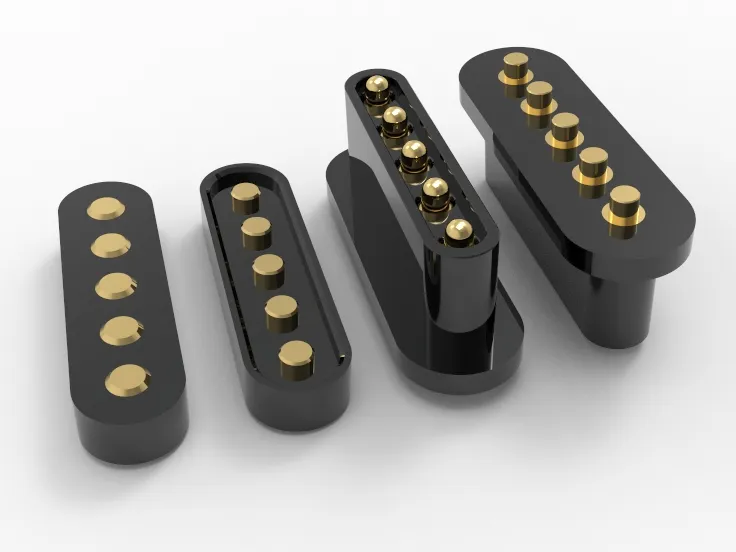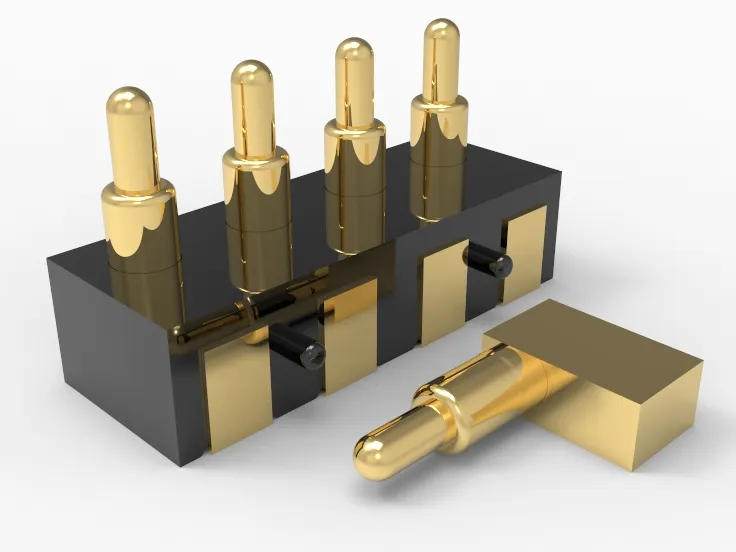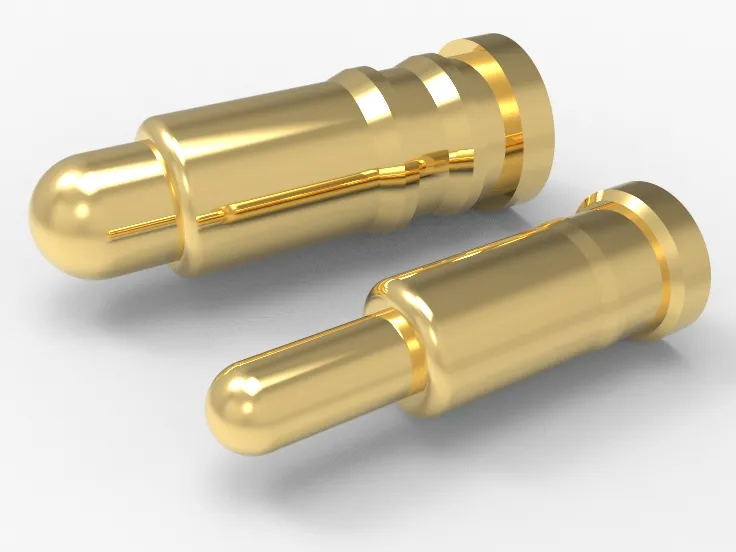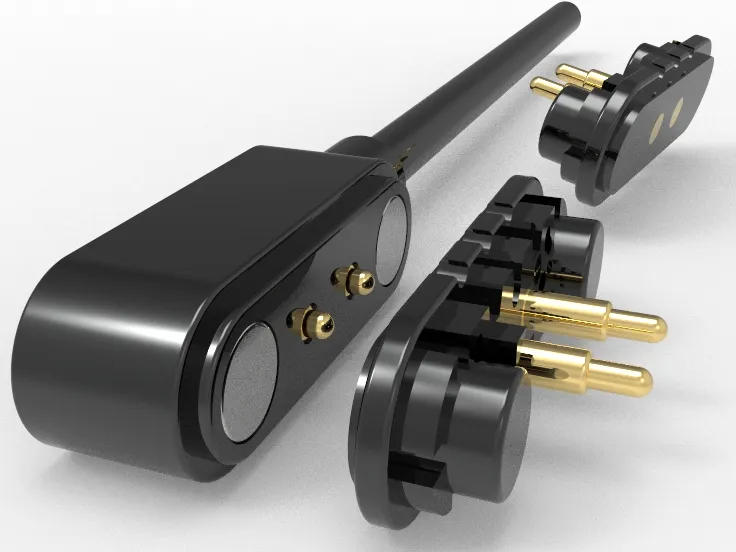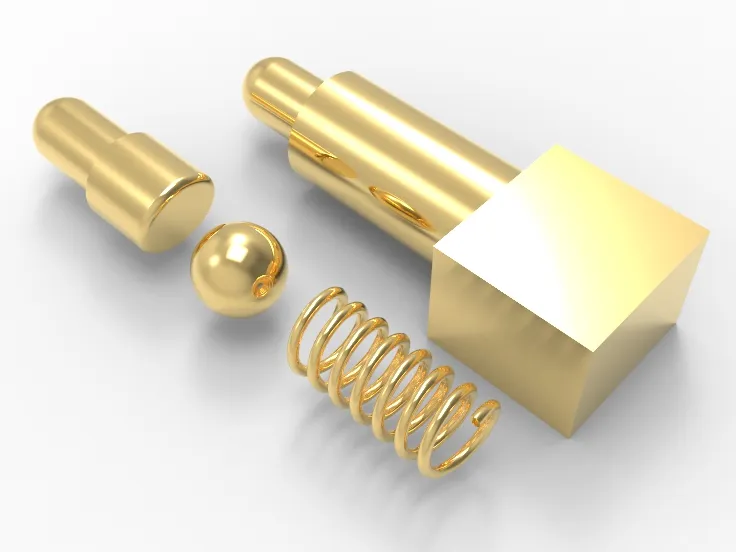Inner Structure Insight: Understand the Inner Structure of Pogo Pins to Get the Best Current Ratings for Maximum Performance and Durability
Introduction: Inner Structure of Pogo Pins
In the world of electronic components, Pogo pins are renowned for their superior connectivity and reliability. Have you ever wondered what crucial details are behind these seemingly simple pins that determine their performance?
We’re going to explore the seven vital aspects of Pogo pins that drive their impressive performance in this article. We will provide authoritative insight and practical advice on their design and application. If you’re passionate about electronic connectivity, this article is a must-read!
1: Basic Inner Structure of Pogo Pins
Pogo pins are high-precision connectors used for electrical connections, available in three-piece, four-piece, and five-piece designs. Each has unique features and advantages:
1.1 Three Piece: Pogo Pin Inner Structure
Inner Structure:
- Typically made of a plunger tip, a spring, and a barrel. The plunger tip transmits electrical signals, the spring provides pressure for a stable connection, and the tube protects the internal components.
Benefits:
- Simple Design: Lower manufacturing cost due to its basic design, suitable for straightforward applications.
- High Reliability: Stable signal transmission thanks to the spring’s consistent pressure.
- Versatile Use: Ideal for various low to medium complexity electronic connections.
1.2 Four Piece: Pogo Pin Inner Structure
Inner Structure:
- Includes a plunger tip, a spring, a ball, and a barrel. The ball, positioned between the pin head and spring, adds an extra contact point to enhance current capacity and stability.
Benefits:
- Increased Current Capacity: The ball design allows for higher current handling, fitting for power-intensive devices.
- Improved Contact Stability: Additional contact points reduce the risk of poor connections.
- Enhanced Durability: Better suited for frequent insertions and removals, extending lifespan.
1.3 Five Piece: Pogo Pin Inner Structure
Inner Structure:
- Consists of a plunger tip, spring, T-pin, ball, and barrel. The extra P-pin and ball improve both electrical and mechanical performance.
Benefits:
- Excellent Electrical Performance: More contact points and enhanced design offer stable performance for high-frequency or precise applications.
- Optimized Mechanical Performance: Provides better stability, handling greater mechanical stress and frequent use.
- Superior Interference Resistance: Designed to minimize electromagnetic interference, suitable for high-demand electronic and communication devices.
These inner structures make Pogo pins essential components in various electronic devices, meeting diverse application needs and enhancing performance and reliability.
2: Three Types of Plunger Tip
2.1 Bias of Plunger Tip
Features:
- Has a slanted edge near the spring end, giving it a sharp angled surface.
- The angled design helps guide the connection better at the contact point.
- Contact resistance < 50 mΩ.
- Rated current < 3A.
- Length > 2.50 mm.
Function:
- Provides excellent mating performance, ideal for high-precision applications.
- Reduces wear and impact during insertion and removal.
Benefits:
- Enhances connection stability and conductivity.
- Increases durability, reducing damage from insertion and removal.
- Easier insertion and mating, suitable for high-density PCBs.
Applications:
- Common in high-density electronics like smartphones, tablets, and portable devices.
- Used in connectors and test equipment requiring frequent insertion and removal.
2.2 Reverse Drilled of Plunger Tip
Features:
- Tip has an inwardly drilled hole for improved mating accuracy.
- Helps the needle align better at the contact point.
- Contact resistance < 200 mΩ.
- Rated current < 1A.
- Extremely low profile.
Function:
- Offers superior mating stability and accuracy, reducing contact failure.
- Improves reliability in contact with the PCB during insertion and removal.
Benefits:
- Enhances connection reliability and stability.
- Minimizes signal interference and performance issues from poor mating.
- Suitable for high-contact-pressure applications.
Applications:
- Used in high-precision, reliable electronics like medical devices, aerospace, and precision instruments.
- Ideal for high-load and high-frequency insertion, such as test probes and measuring devices.
2.3 Ball Tip or T-pin of Plunger Tip
Features:
- Ball Tip has a small ball at the end, allowing rotation at the contact point.
- T-pin Tip has a T-shaped end for better contact stability and load capacity.
- Contact resistance < 30 mΩ.
- Rated current < 15A.
- Often designed with four or five pieces.
Function:
- Ball Tip design allows self-adjustment during mating, improving stability.
- T-pin design provides a larger contact area, enhancing connection strength.
Benefits:
- Ball Tip offers better wear resistance and self-adjustment.
- T-pin Tip suits applications requiring high contact pressure, providing a more stable connection.
- Increases overall durability and reliability of the connector.
Applications:
- Ball Tip is used in high-current, high-frequency applications like data transmission and test connectors.
- T-pin Tip is suitable for high-strength and stability needs, such as high-load power connections and high-power electronics.
3: Importance and Types of Springs in Pogo Pins
The spring in a Pogo Pin is crucial. Its design allows the pin to move smoothly between different contact surfaces, ensuring a reliable and stable electrical connection.
3.1 Types of Springs:
- Compression Spring: The most common type, it maintains pin stability and flexibility by compressing.
- Tension Spring: Provides pulling force between pins, ensuring stable contact over time.
- Torsion Spring: Offers rotational stability between different pin angles.
3.2 Importance of Springs: Springs in Pogo Pins do more than just maintain contact:
- Automatic Adjustment: Adapts to varying pressure and surface unevenness.
- Extended Lifespan: Reduces wear on contact points, prolonging device life.
- Signal Continuity: Ensures steady signal transmission and minimizes interference.
3.3 Benefits of Springs:
- Enhanced Reliability: Improves connection stability and reduces poor contact risk.
- Performance Boost: Ensures stable signal transmission, enhancing device performance.
- Versatility: Fits various surfaces and pressure needs, used in electronics, smart devices, and testing equipment.
Even though the spring in a Pogo Pin seems simple, its clever design and powerful function provide unmatched stability and reliability for modern electronics. It’s a key hero in technical details, ensuring our devices operate smoothly.
4: Sealing and Durability of Pogo Pin Barrel
The Barrel of a Pogo Pin is an innovative solution in electronic connections, known for its unique design and superior performance. It plays a critical role in electronic device connections and signal transmission, providing high reliability and durability.
4.1 High-Quality Materials:
- The Barrel uses top-notch conductive materials to ensure reliable signal transmission. Its internal conductive spring design counteracts external vibrations and interference, offering stable performance.
- This design not only boosts connection stability but also extends the Barrel’s lifespan, reducing maintenance and replacement needs.
4.2 Durable Structure:
- The external structure of the Barrel is highly resistant to wear and corrosion. Its specially treated surface withstands oxidation and wear, ensuring long-term use without affecting connection quality.
- This durability allows the Barrel to perform excellently in extreme conditions, whether high temperatures, humidity, or vibrations.
4.3 Mechanical Stability:
- The Barrel features a compact design and precise manufacturing, ensuring tight fitting with connectors. This prevents signal loss or interference caused by loose or misaligned connections.
- The high-precision design ensures connection reliability, making the Barrel widely and efficiently used in electronic devices.
The Pogo Pin Barrel stands out in electronic connections for its high-quality conductive materials, wear and corrosion resistance, and excellent mechanical stability. Its design enhances device performance and user experience, marking a significant advancement in electronic connection technology.
5: Contact Force Adjustment and Optimization
- Pogo Pin’s contact force is the pressure applied to the mating surface during contact. Too little force can cause poor contact, while too much can lead to wear. Thanks to its high-precision spring, Pogo Pin automatically achieves optimal connection stability, adjusting accurately even on uneven surfaces.
- Optimizing this force enhances performance and overall device reliability, ensuring stable contact and reducing wear. This results in increased durability and lower maintenance costs.
6: Wear Resistance and Fatigue Design
- Pogo Pin connectors are highly durable, withstanding over 10,000 insertions while maintaining stable electrical performance. The spring material is designed to remain elastic under frequent use, avoiding failure due to fatigue.
- This makes Pogo Pin a reliable choice for high-frequency operations, offering long-lasting stability.
7: Custom Design, Inner Structure of Pogo Pins
Customization is key in electronic connections. Pogo Pin can be tailored to meet specific application needs:
- High Current Applications: For currents up to 1,200A, we optimize contact points and conductive materials to ensure stable performance, including larger contact areas and durable materials.
- High Frequency Applications: We enhance signal integrity and reduce interference through improved spring design and contact surface treatment.
- Special Environments: For extreme conditions, we use high-temperature and corrosion-resistant materials and effective sealing to protect internal components.
Conclusion
The seven key details of Pogo Pin’s internal structure, including basic design, spring and needle design, wear resistance, stability, and customizability, significantly impact performance. Choosing the right Pogo Pin can optimize your application needs. Contact us for tailored solutions.




